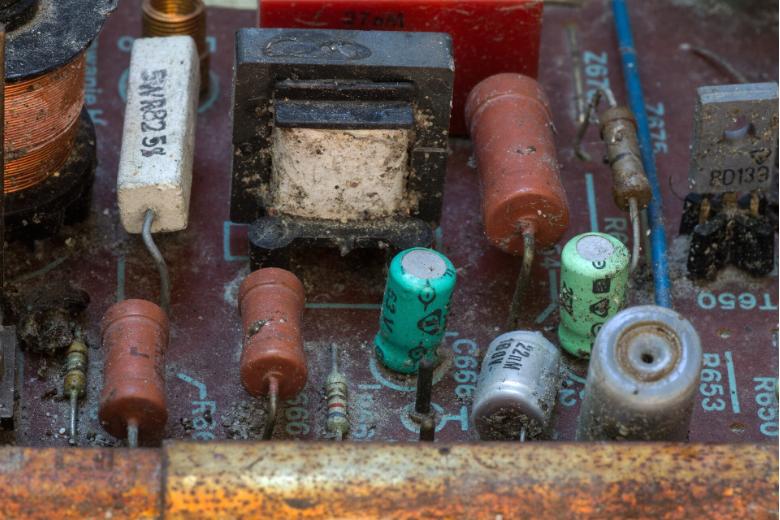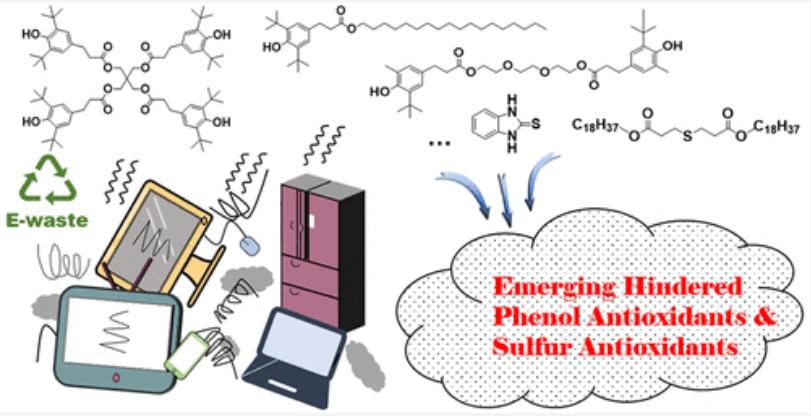博文
回收电子垃圾会释放出合成抗氧化剂
 精选
精选
||
回收电子垃圾会释放出合成抗氧化剂
诸平

E-waste. Credit: CC0 Public Domain
据美国化学会(American Chemical Society)2021年12月15日提供的消息,制造商在塑料、橡胶和其他聚合物中添加合成抗氧化剂,使其使用寿命更长。然而,这些化合物对健康的影响,以及它们如何迁移到环境中,在很大程度上是未知的。2021年12月15日,中国广州的暨南大学研究人员在《美国化学学会的环境科技快报学》(ACS' Environmental Science & Technology Letters)网站发表了他们的最新研究成果——Chunyou Zhu, Zibin Pan, Bibai Du, Bowen Liang, Yuqing He, Hui Chen, Liangying Liu, Lixi Zeng. Massive Emissions of a Broad Range of Emerging Hindered Phenol Antioxidants and Sulfur Antioxidants from E‑Waste Recycling in Urban Mining: New Insights into an Environmental Source. Environmental Science & Technology Letters, Publication Date:December 15, 2021. DOI: 10.1021/acs.estlett.1c00866. http://pubs.acs.org/doi/abs/10.1021/acs.estlett.1c00866
此文报告说,已经在电子垃圾(electronic waste简称E-waste)回收车间的灰尘中检测到广泛的合成抗氧化剂,被称为受阻酚(hindered phenol)和硫抗氧化剂(sulfur antioxidants),可能会对暴露在这样环境里的工人身体健康构成威胁(E-waste recycling emits emerging synthetic antioxidants)。
先前的研究表明,广泛的环境污染和人类接触一类被称为低分子量合成酚抗氧化剂(low-molecular weight synthetic phenolic antioxidants)的化合物。在实验室实验中,这些化合物当中的一些化合物对啮齿动物或人类细胞(human cells)是有毒的。近年来,制造商们推出了一类高分子量合成酚抗氧化剂(high-molecular weight synthetic phenolic antioxidants),也被称为受阻酚抗氧化剂(hindered phenol antioxidants简称HPAs),具有提高性能和从产品迁移速度较慢的特点。除了HPAs外,硫抗氧化剂(sulfur antioxidants简称SAs)通常作为“辅助”抗氧化剂("helper" antioxidants)被添加到橡胶和塑料聚合物中。这些新化合物大多数的毒理学效应和对环境的影响尚不清楚。因此,曾丽喜(Lixi Zeng音译)和同事们想要调查电子垃圾回收中心车间灰尘中出现HPAs和SAs的情况,那里有大量的废弃电子产品,如笔记本电脑(laptop computers)、手机、平板电脑、液晶显示屏、电视机、打印机、各种电源线、电缆等被拆卸和加工。
2020年8月,中国广州的暨南大学研究人员从中国宜春市一个工业园区的电子垃圾回收车间收集了45个粉尘样本,分别是电线电缆拆解、电子塑料加工和一般电子垃圾拆解。然后,他们使用液相色谱/串联质谱法(liquid chromatography/tandem mass spectrometry)对样品进行筛查,其中有18个出现HPAs和6个出现SAs。在尘埃样品中被检测到24种化合物,有22种化合物是首次检测到,与其他电子垃圾污染物相比,有些化合物的含量相对较高。虽然不同类型车间的SAs粉尘浓度相似,但拆解电线电缆和加工电子塑料的中心的粉尘HPAs水平显著高于拆解一般电子垃圾的中心。研究人员说,鉴于电子垃圾粉尘中出现的HPAs和SAs无处不在,需要对它们的环境行为、毒性和风险进行进一步的深入研究。
上述介绍,仅供参考。欲了解更多信息,敬请注意浏览原文或者相关报道。
Urban wastes used as fertilizers contain higher PFAS than livestock manure

To recognize new pollution caused by synthetic antioxidants in the environment, a wide range of 18 emerging hindered phenol antioxidants (HPAs) and 6 emerging sulfur antioxidants (SAs) were investigated, for the first time, through a dedicated target screening in representative e-waste recycling indoor work environments. All 18 emerging HPAs and 6 emerging SAs were detected in 45 e-waste dust samples collected from different categories of recycling workshops. Of the 24 detected target antioxidants, 22 were first reported in e-waste dust and 9 were newly identified in the environment. Pentaerythritol tetrakis[3-(3,5-di-tert-butyl-4-hydroxyphenyl)] propionate (Irganox 1010), octadecyl 3-(3,5-di-tert-butyl-4-hydroxyphenyl) propionate (Irganox 1076), and triethylene glycol bis(3-tert-butyl-4-hydroxy-5-methylphenyl) propionate (Irganox 245) were the most abundant antioxidants, with median levels of 1560–4700 ng/g, comparable to or higher than those of other e-waste pollutants. Significantly positive or negative correlations were observed among these “novel” antioxidants, indicating that they have similar or competitive uses in electronic products. Waste wires and cables and waste electronic plastics were identified as the two main sources of emission of HPAs to the indoor environments during e-waste recycling. Our findings raise the need for further investigations of the environmental behavior, fate, and risks of these widely used but rarely evaluated “novel” antioxidants.
https://blog.sciencenet.cn/blog-212210-1316907.html
上一篇:“分裂”光子的发现提供了一种观察光的新方法
下一篇:Science:磁性“刺猬”可以在很小的空间内存储大数据